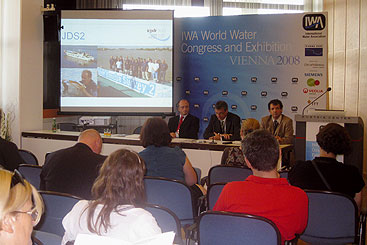Results from the Joint Danube Survey 2 distributed internationally
ICPDR Danube Watch: New EU members bring their own sea: good news or bad?

Results from the Joint Danube Survey 2
distributed internationally
Results from the largest Danube research expedition will improve the ability of Danube country leaders to decide on what to do to address pollution and other problems in the region.

The final results of the JDS2 expedition were released as part of the International Water Association’s conference in Vienna.
On September 11, 2008, the final results of the JdS2
expedition were publicly presented during a press
conference at the World Water Congress and Exhibition
of the International Water Association (IWA)
in Vienna, Austria.
The accompanying press release was widely distributed internationally. International media that covered the story included Associated Press, Reuters, Agence Presse Francaise and the International Herald Tribune. In Austria, media coverage included articles in Die Presse and Der Standard.
Presenting the results to the public. The final results of the JDS2 were published in two key documents: a `Final Scientific Report´ and a hands-on public document – `The Joint Danube Survey 2: Research Expedition and Conclusions´.
The `Final Scientific Report´ is a thick and technical document full of scientific terms and Latin names that provides a comprehensive assessment about the status of a number of parameters that needed to be measured to fulfill the requirements of the EU Water Framework Directive. The Final Scientific Report is understandable for scientists, but a member of the general public would have a difficult time getting through it.
For this reason, the shorter hands-on public document – `The Joint Danube Survey 2: Research Expedition and Conclusions´ – was created. It is hoped that this will give readers a very good idea of what was found out, within a short amount of time and space. While its information will not explain everything that was assessed during the JDS2, it does try to give an overall snapshot with highlights and definitions of complicated scientific terms. The overall scientific results are divided into three sections: biology, chemistry and hydromorphology.
All of the above – press release, media coverage, final results and the two documents – can be viewed online at www.icpdr.org/jds. A CD-ROM including all of the technical information is available from the ICPDR. And a full story about the JDS2 results was published in the last Danube Watch 02/2008.
At the time of writing this article, plans were also under way for the JDS2 final results to be publicly presented through national press conferences in the Danube countries, to maximise media coverage nationwide.





